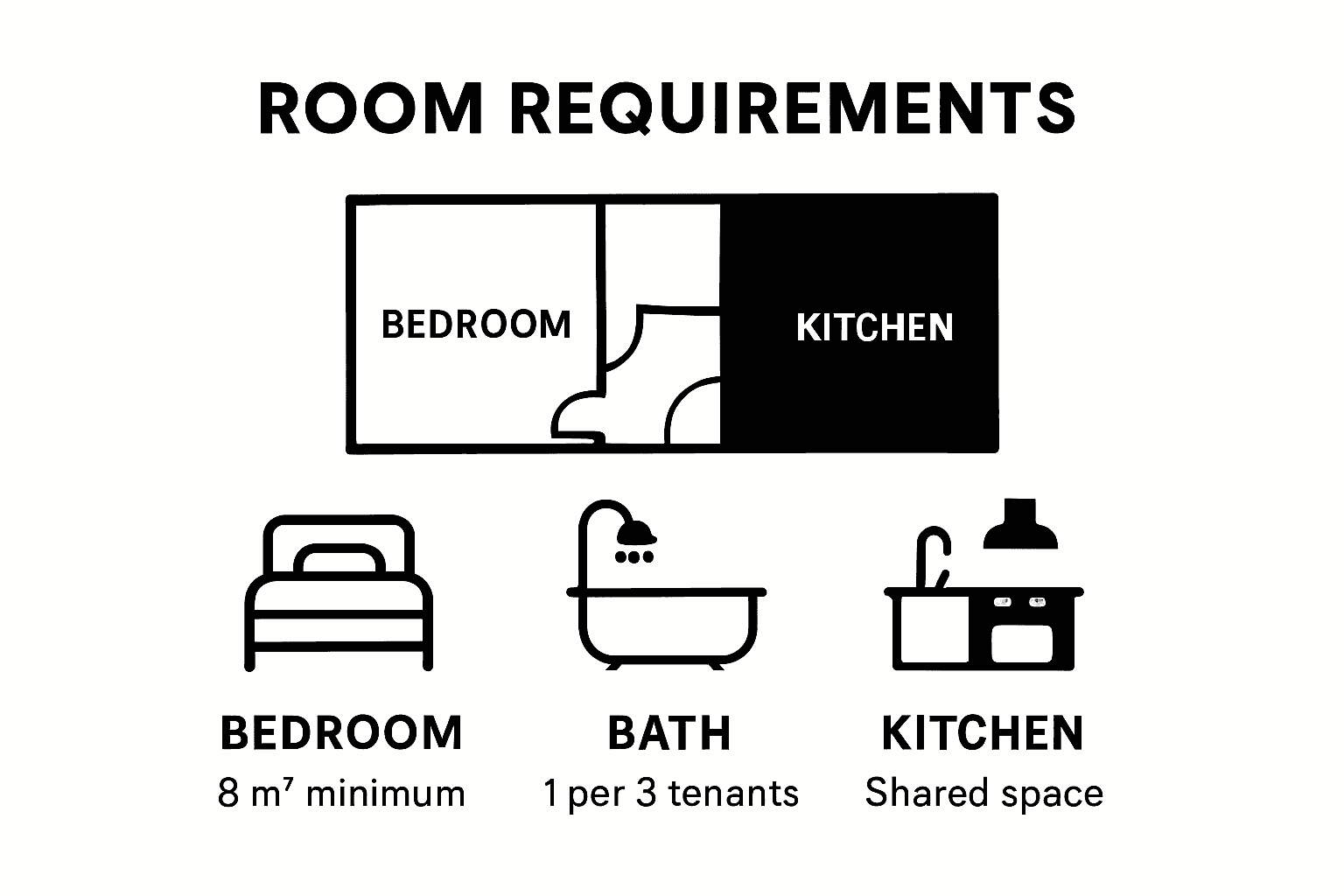HMO floor plans seem like simple blueprints at first glance, just showing where the walls and doors go in a shared house. Yet step inside the world of shared living and you will find every line and measurement has legal and financial weight. Surprising as it sounds, a well-designed HMO layout can boost your property value by up to 20 percent compared to standard homes. That is why the real power of an HMO floor plan lies not in its appearance but in its silent ability to attract investors, satisfy regulations, and protect tenant safety all at once.
Quick Summary
| Takeaway | Explanation |
|---|---|
| HMO floor plans ensure tenant safety | They incorporate vital safety features like fire escapes and emergency access pathways for occupants. |
| Legal compliance is essential for HMO plans | Floor plans must meet stringent local housing regulations to prevent legal issues and obtain licensing. |
| Space efficiency maximises rental income | Well-designed layouts can significantly increase occupancy potential and return on investment for property owners. |
| Strategic design enhances tenant comfort | Effective space distribution promotes both privacy and access to communal areas, improving tenant satisfaction. |
| Professional designs influence property valuation | Quality HMO floor plans can raise a property’s market value by potentially 20% compared to standard layouts. |
Defining HMO Floor Plans: Key Features Explained
An HMO floor plan represents a detailed architectural blueprint specifically designed for Houses in Multiple Occupation (HMO), revealing how shared living spaces are organised and individual tenant zones are strategically configured. Unlike standard residential property layouts, HMO floor plans demand precise spatial planning to ensure legal compliance, tenant safety, and optimal space utilisation.
The Essential Structural Components
HMO floor plans are distinguished by their intricate design considerations that prioritise functionality and regulatory requirements. These layouts must meticulously map out critical elements such as:

- Shared Common Areas: Kitchen, living spaces, and communal facilities that accommodate multiple tenants
- Private Bedroom Zones: Individual rooms with specific minimum size requirements
- Sanitary Facilities: Strategically positioned bathrooms and toilets ensuring adequate provision for tenant numbers
According to Royal Institution of Chartered Surveyors, comprehensive HMO floor plans must demonstrate clear delineation between shared and private spaces while maintaining legal occupancy standards.
Regulatory Compliance and Safety Considerations
Effective HMO floor plans go beyond aesthetic design. They are critical documents that demonstrate compliance with stringent housing regulations. Professional floor plans must explicitly showcase:
- Fire escape routes
- Precise room measurements
- Location of fire safety equipment
- Electrical and gas connection points
- Emergency access pathways
These technical specifications ensure that the property meets local authority requirements and provides a safe living environment for multiple occupants. Read more about HMO property management to understand the comprehensive considerations involved in creating compliant floor plans.
Ultimately, an exceptional HMO floor plan transforms abstract spatial arrangements into a functional, legally compliant living solution that balances tenant privacy, comfort, and safety within a shared residential framework.

The Importance of HMO Floor Plans in Property Investment
HMO floor plans are not merely technical drawings but strategic investment tools that significantly impact property valuation, marketability, and potential rental income. These meticulously designed blueprints serve as critical documents that demonstrate a property’s potential for maximising occupancy and delivering attractive returns for property investors.
Financial Valuation and Investment Potential
A professionally crafted HMO floor plan directly influences a property’s market value and investment attractiveness. Investors and mortgage lenders scrutinise these layouts to assess the property’s capacity for generating consistent rental revenue. Key financial considerations include:
- Room Configuration: Number and size of rentable spaces
- Occupancy Potential: Maximum legal tenant capacity
- Space Efficiency: Optimised layout for maximum rental yield
Research from the Royal Institution of Chartered Surveyors indicates that well-designed HMO floor plans can increase property valuation by up to 20% compared to standard residential layouts.
Regulatory Compliance and Risk Mitigation
Beyond financial metrics, HMO floor plans are crucial risk management instruments. They demonstrate a property’s adherence to complex housing regulations, which is essential for obtaining necessary licensing and avoiding potential legal complications. Professional floor plans provide:
- Clear documentation of safety features
- Proof of compliance with minimum room size requirements
- Comprehensive evidence of proper tenant accommodation standards
Investors can explore HMO property investment strategies to understand how strategic floor planning minimises regulatory risks and enhances investment security.
Ultimately, a sophisticated HMO floor plan represents more than architectural design. It is a sophisticated investment document that communicates a property’s potential, demonstrates regulatory compliance, and serves as a foundational tool for successful property portfolio management.
Understanding Space Utilisation in HMO Floor Plans
Space utilisation in HMO floor plans represents a sophisticated art of maximising functional living areas while meeting strict regulatory requirements. Unlike traditional residential properties, HMO spaces demand intelligent architectural strategies that balance individual privacy, shared amenities, and legal occupancy standards.
Strategic Space Allocation Principles
Effective HMO floor plans employ nuanced approaches to space distribution that go beyond simple square metre calculations. Property investors and designers must carefully consider multiple dimensions of spatial efficiency:
- Functional Zoning: Creating distinct areas for sleeping, working, socialising
- Circulation Spaces: Ensuring smooth movement between private and communal areas
- Multipurpose Design: Developing flexible spaces that serve multiple tenant needs
Research from the UK Housing Research Institute highlights that successful space utilisation can increase a property’s rental potential by up to 35% compared to traditional layouts.
Regulatory and Practical Constraints
Space utilisation in HMO floor plans is fundamentally constrained by local authority regulations and practical living requirements. These constraints demand precise architectural solutions that address:
- Minimum room size requirements
- Adequate natural lighting provisions
- Proper ventilation standards
- Fire safety escape route configurations
Explore detailed HMO property planning insights to understand the intricate balance between design creativity and regulatory compliance.
Ultimately, masterful space utilisation transforms HMO floor plans from mere architectural drawings into intelligent living environments that maximise both tenant comfort and property investment potential.
Legal and Regulatory Considerations for HMO Floor Plans
HMO floor plans are not just architectural designs but legally binding documents that must adhere to complex regulatory frameworks governing multiple occupancy properties. These intricate guidelines ensure tenant safety, maintain minimum living standards, and protect both property investors and occupants from potential legal complications.
Mandatory Licensing and Compliance Requirements
Local authorities impose stringent regulations that directly impact HMO floor plan designs. Property owners must navigate a complex landscape of legal prerequisites that dictate every aspect of spatial configuration. Key compliance elements include:
- Room Size Regulations: Minimum square metre requirements for individual bedrooms
- Occupancy Density Controls: Maximum permitted tenant numbers based on property dimensions
- Safety Infrastructure: Mandatory fire escape routes and emergency provisions
According to UK Government Housing Regulations, properties accommodating five or more tenants from multiple households require mandatory HMO licensing, with floor plans serving as critical documentation for approval.
Safety and Habitability Standards
Beyond basic spatial requirements, HMO floor plans must demonstrate comprehensive safety and habitability provisions. Professional designs must explicitly address:
- Adequate natural lighting in all living spaces
- Proper ventilation mechanisms
- Sufficient sanitary facilities
- Clear emergency access pathways
- Electrical and gas safety infrastructure
Explore comprehensive HMO property guidelines to understand the nuanced legal landscape surrounding multiple occupancy property management.
Ultimately, successful HMO floor plans represent a delicate balance between architectural creativity, tenant comfort, and rigorous regulatory compliance. Property investors who master these intricate legal considerations can transform potential regulatory challenges into strategic investment opportunities.
The following table summarises the core legal and regulatory considerations for HMO floor plans, helping readers visualise the major requirements that must be addressed.
| Regulatory Element | Description |
|---|---|
| Room Size Regulations | Minimum square metre requirements for individual bedrooms to ensure adequate living space |
| Occupancy Density Controls | Maximum number of tenants permitted based on property dimensions |
| Safety Infrastructure | Mandatory inclusion of fire escape routes and emergency provisions |
| Sanitary Facilities | Sufficient bathrooms and toilets based on the number of occupants |
| Natural Lighting & Ventilation | Requirements for adequate daylight and airflow in all living spaces |
| Electrical & Gas Safety | Standards for safe installation and accessibility of electrical and gas infrastructure |
| Licensing Documentation | Submission of detailed floor plans as part of mandatory local authority HMO licensing applications |
Real-World Examples: Successful HMO Floor Plans
Successful HMO floor plans transform theoretical design principles into practical living solutions that maximise space efficiency, tenant comfort, and investment potential. These strategic layouts demonstrate how intelligent architectural planning can overcome complex spatial challenges while meeting rigorous regulatory standards.
Urban Conversion Strategies
Modern HMO floor plans excel at reimagining existing residential structures to accommodate multiple tenants without compromising individual living standards. Innovative design approaches typically involve:
- Vertical Space Optimisation: Converting unused attic or basement areas into functional living quarters
- Modular Room Configurations: Creating flexible spaces that adapt to changing tenant requirements
- Smart Partition Techniques: Developing semi-private zones within shared living environments
Research from the Royal Institution of Chartered Surveyors indicates that well-executed urban conversion strategies can increase property value by up to 40% compared to traditional layouts.
Strategic Design Principles
Successful HMO floor plans integrate multiple considerations beyond mere spatial arrangement. Professional designers focus on creating holistic living environments that balance practicality, legal compliance, and tenant experience:
- Seamless integration of private and communal spaces
- Intelligent circulation pathways
- Efficient utility infrastructure placement
- Comprehensive safety feature incorporation
Explore innovative architectural approaches to understand how cutting-edge design transforms challenging properties into high-performing HMO investments.
Ultimately, exceptional HMO floor plans represent more than architectural blueprints. They are sophisticated investment tools that demonstrate how thoughtful design can simultaneously address tenant needs, regulatory requirements, and property investment potential.
This table illustrates how well-designed HMO floor plans impact financial and tenancy-specific factors compared to standard residential layouts, providing a concise overview for property investors.
| Factor | Standard Residential Layout | Well-Designed HMO Floor Plan |
|---|---|---|
| Property Value Impact | Baseline | Up to 20% higher |
| Occupancy Potential | Limited (single household) | Multiple legal tenants |
| Rental Income Yield | Lower per square metre | Maximised with efficient space use |
| Regulatory Compliance | Simpler | Requires strict, documented adherence |
| Investment Attractiveness | Modest | High (subject to compliance and design) |
Ready to Optimise Your HMO Investment?
Have you realised how essential a professional HMO floor plan is for legal compliance and maximum rental returns? This article explained why getting your HMO layout right is critical, from room size requirements to fire safety routes. If you are concerned about meeting complex regulations or increasing your property’s earning potential, you are not alone. Many landlords and investors face these exact challenges when trying to turn architectural drawings into profitable, compliant HMOs.
At AgentHMO, we specialise in the UK HMO market. Find trusted partners for HMO planning and regulatory advice, connect directly with HMO professionals and discover expert resources tailored for your investment needs. Do not let uncertainty about floor plans or compliance hold you back. Visit our main platform now to unlock more support for your HMO journey and take the next step towards a profitable and secure property portfolio.
Frequently Asked Questions
What is an HMO floor plan?
An HMO floor plan is a detailed architectural blueprint designed for Houses in Multiple Occupation, showing the arrangement of shared living spaces and individual tenant zones tailored for legal compliance and optimal space utilisation.
Why are HMO floor plans important in property investment?
HMO floor plans are vital as they directly influence property valuation, marketability, and potential rental income by demonstrating a property’s potential for maximising occupancy and ensuring adherence to legal standards.
What are the key features included in an HMO floor plan?
Key features of an HMO floor plan include shared common areas, private bedroom zones, sanitary facilities, fire escape routes, and compliance with minimum room size and safety standards.
How do HMO floor plans contribute to tenant safety?
HMO floor plans contribute to tenant safety by detailing fire escape routes, ensuring proper placement of safety equipment, and illustrating compliance with housing regulations designed to protect multiple occupants.

